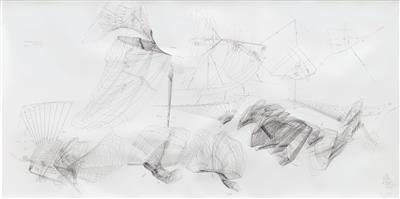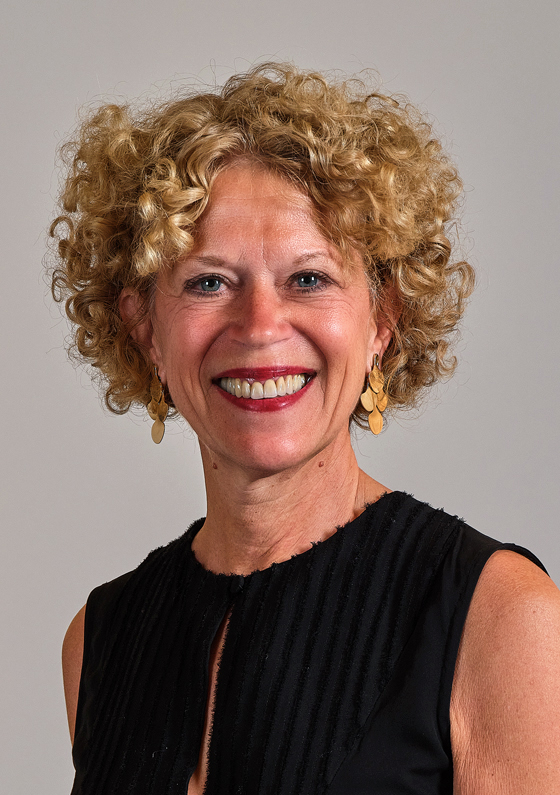Jorinde Voigt *

(born in Frankfurt/Main in 1977)
WV 2010–535 - Territorium; oil, water, electricity, gas, 2010, signed, dated Jorinde Voigt Berlin 2010, inscribed with the technique, ink, pencil on strong paper, 113.5 x 226 cm, framed
Provenance:
Gallery Johann König, Berlin
Gallery Parisa Kind, Frankfurt am Main
Private Collection, North Rhine-Westphalia - acquired from the above
Exhibited:
Gallery Parisa Kind, Frankfurt am Main, Art Forum Berlin, 07.-10. October 2010
Wuppertal, Von der Heydt-Museum, Nexus, 15. March-19. June 2011
Pécs, Hungary, Pécsi Galéria és Vizuális Műhely, Jorinde Voigt: Territorium/Terület, 08. April-08. May 2011
Düsseldorf, Weltkunstzimmer, Inside Ecologies - Umwelt als Interkation, 14. September-04. November 2018
Gallery Bernd Klüser, Munich, Art Cologne, 11.-14. April 2019
In her oeuvre, Jorinde Voigt often deals with the visualisa-tion of actually invisible everyday phenomena. Her work touches on mathematics, biology, physics, music and also politics. Jorinde Voigt is especially known for her graphic works in which she visualises sounds, noises, rhythms and melodies. This approach has its roots in her early life. Before studying fine arts under Katharina Sieverding, the artist received an intensive classical music education.
At first glance, Voigt’s works are primarily composed of graceful arcs and lines that fill a usually very large surface. On closer inspection, it becomes clear, especially through the detailed inscriptions of the individual arcs and lines, that her works also rest on a complex, conceptual foundation. For each new work that Jorinde Voigt creates, she first establishes an algorithm, a certain structure, according to which the subsequent work then unfolds. The artist publishes the concept underlying her works on her homepage, so that the recipient can follow the creative process.
The artist first dealt with the “territory” theme in 2006. Four years later, she was invited by a large German energy company to gain an insight into how their company was structured. On site, the artist saw plans of the various energy sectors, such as gas, electricity, oil, wind and nuclear power. The work WV 2010-535 illustrates in its entirety several territories, i.e. different areas enclosed by borders. The areas referred to as “centre” form the centres of the individual territories. The north-south-east-west axes run through these centres. The territory as well as the associated centre always have the same numbering: territory (1) + centre (1), territory (2) + centre (2) etc.
The term “centre” is supplemented and extended by further terms in the work WV 2010-535. The four other territories form an oil, water, electricity and gas territory. These partly also replace the term “centre” within the respective territory. In this case, the area designated as territory explicitly becomes, for instance, a water or oil territory. The N,S,W,O axes denote the cardinal points within the respective territory. When several territories are superimposed on one anoher, the cardinal point rotates. Along the axes of the compass, the terms “construction” and “deconstruction” are alternately written down in pencil. Voigt defines the terms of her concept as follows:
“‘Construction’ denotes operations such as the creation of reality through social processes, the construction of belonging in the territorial sense, the construction of reality in the conceptual sense, considerations and actions that lead to the creation of a new situation, the production of identity, thought models and their connotations. ‘Deconstruction’ is the name given to all this, but in a dialectically complementary sense. Nevertheless, construction and deconstruction fall structurally into one point. This parameter constellation is used to name an area where both occur simultaneously. In that sense, it refers to a neutral field of change.”
(http://jorindevoigt.com/blog/wp-content/wp-content/uploads/KONZEPT-Territorium_D.doc.pdf, 14.09.2020)
The centres of the territories are linked chronologically by time specifications such as after 1 day, after 2 days, etc. At the end, the last point is temporally linked to the first in the same way. This results in a loop structure that allows the entire sequence to run infinitely and to develop its own rhythm. The artist wrote the dates and the continental borders on the picture surface in red pencil.
Expert: Dr. Petra Maria Schäpers
 Dr. Petra Maria Schäpers
Dr. Petra Maria Schäpers
petra.schaepers@dorotheum.de
25.11.2020 - 16:00
- Odhadní cena:
-
EUR 60.000,- do EUR 80.000,-
Jorinde Voigt *
(born in Frankfurt/Main in 1977)
WV 2010–535 - Territorium; oil, water, electricity, gas, 2010, signed, dated Jorinde Voigt Berlin 2010, inscribed with the technique, ink, pencil on strong paper, 113.5 x 226 cm, framed
Provenance:
Gallery Johann König, Berlin
Gallery Parisa Kind, Frankfurt am Main
Private Collection, North Rhine-Westphalia - acquired from the above
Exhibited:
Gallery Parisa Kind, Frankfurt am Main, Art Forum Berlin, 07.-10. October 2010
Wuppertal, Von der Heydt-Museum, Nexus, 15. March-19. June 2011
Pécs, Hungary, Pécsi Galéria és Vizuális Műhely, Jorinde Voigt: Territorium/Terület, 08. April-08. May 2011
Düsseldorf, Weltkunstzimmer, Inside Ecologies - Umwelt als Interkation, 14. September-04. November 2018
Gallery Bernd Klüser, Munich, Art Cologne, 11.-14. April 2019
In her oeuvre, Jorinde Voigt often deals with the visualisa-tion of actually invisible everyday phenomena. Her work touches on mathematics, biology, physics, music and also politics. Jorinde Voigt is especially known for her graphic works in which she visualises sounds, noises, rhythms and melodies. This approach has its roots in her early life. Before studying fine arts under Katharina Sieverding, the artist received an intensive classical music education.
At first glance, Voigt’s works are primarily composed of graceful arcs and lines that fill a usually very large surface. On closer inspection, it becomes clear, especially through the detailed inscriptions of the individual arcs and lines, that her works also rest on a complex, conceptual foundation. For each new work that Jorinde Voigt creates, she first establishes an algorithm, a certain structure, according to which the subsequent work then unfolds. The artist publishes the concept underlying her works on her homepage, so that the recipient can follow the creative process.
The artist first dealt with the “territory” theme in 2006. Four years later, she was invited by a large German energy company to gain an insight into how their company was structured. On site, the artist saw plans of the various energy sectors, such as gas, electricity, oil, wind and nuclear power. The work WV 2010-535 illustrates in its entirety several territories, i.e. different areas enclosed by borders. The areas referred to as “centre” form the centres of the individual territories. The north-south-east-west axes run through these centres. The territory as well as the associated centre always have the same numbering: territory (1) + centre (1), territory (2) + centre (2) etc.
The term “centre” is supplemented and extended by further terms in the work WV 2010-535. The four other territories form an oil, water, electricity and gas territory. These partly also replace the term “centre” within the respective territory. In this case, the area designated as territory explicitly becomes, for instance, a water or oil territory. The N,S,W,O axes denote the cardinal points within the respective territory. When several territories are superimposed on one anoher, the cardinal point rotates. Along the axes of the compass, the terms “construction” and “deconstruction” are alternately written down in pencil. Voigt defines the terms of her concept as follows:
“‘Construction’ denotes operations such as the creation of reality through social processes, the construction of belonging in the territorial sense, the construction of reality in the conceptual sense, considerations and actions that lead to the creation of a new situation, the production of identity, thought models and their connotations. ‘Deconstruction’ is the name given to all this, but in a dialectically complementary sense. Nevertheless, construction and deconstruction fall structurally into one point. This parameter constellation is used to name an area where both occur simultaneously. In that sense, it refers to a neutral field of change.”
(http://jorindevoigt.com/blog/wp-content/wp-content/uploads/KONZEPT-Territorium_D.doc.pdf, 14.09.2020)
The centres of the territories are linked chronologically by time specifications such as after 1 day, after 2 days, etc. At the end, the last point is temporally linked to the first in the same way. This results in a loop structure that allows the entire sequence to run infinitely and to develop its own rhythm. The artist wrote the dates and the continental borders on the picture surface in red pencil.
Expert: Dr. Petra Maria Schäpers
 Dr. Petra Maria Schäpers
Dr. Petra Maria Schäpers
petra.schaepers@dorotheum.de
|
Horká linka kupujících
Po-Pá: 10.00 - 17.00
kundendienst@dorotheum.at +43 1 515 60 200 |
| Aukce: | Současné umění I |
| Typ aukce: | Sálová aukce s Live bidding |
| Datum: | 25.11.2020 - 16:00 |
| Místo konání aukce: | Wien | Palais Dorotheum |
| Prohlídka: | online |
Všechny objekty umělce
